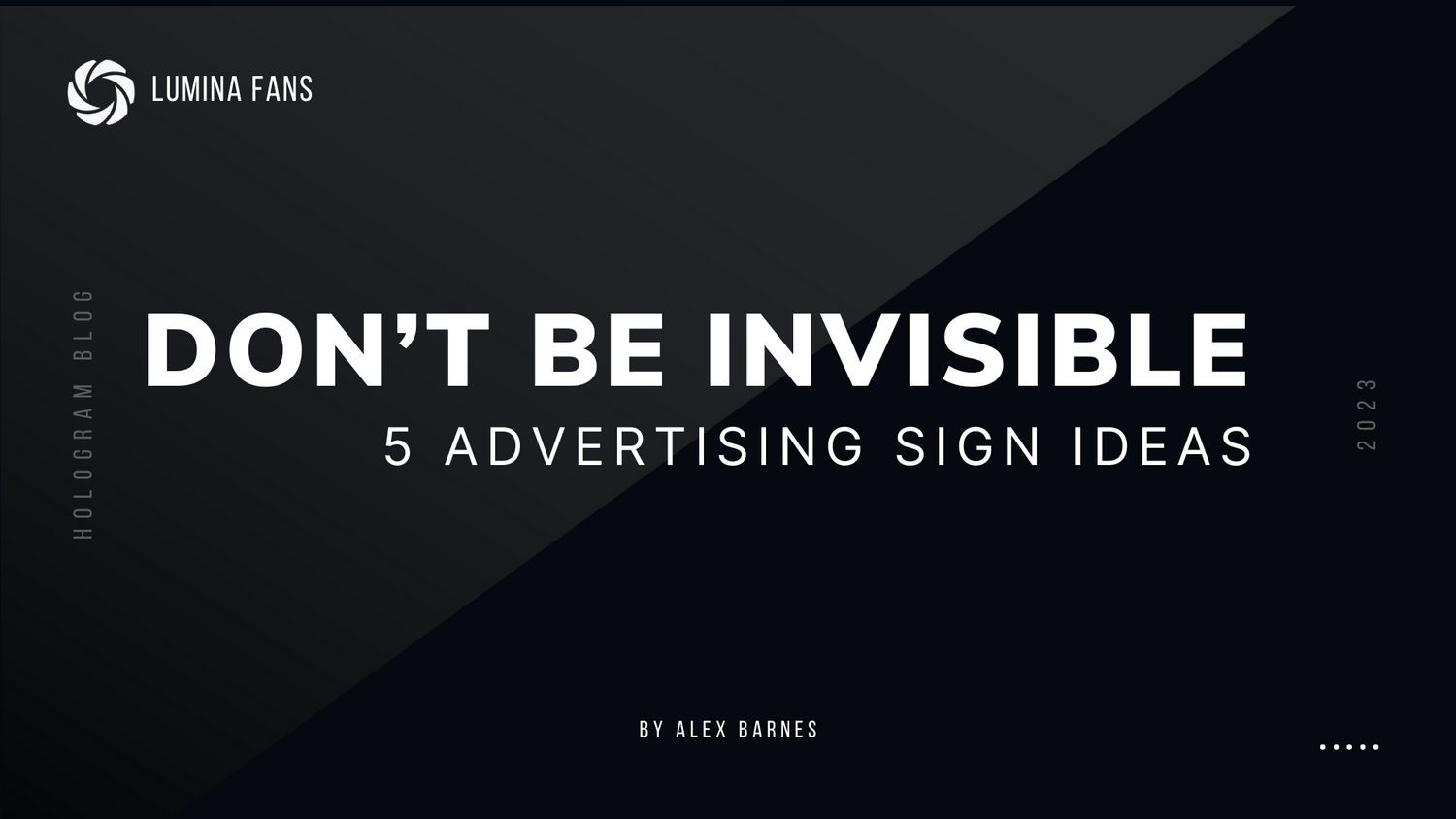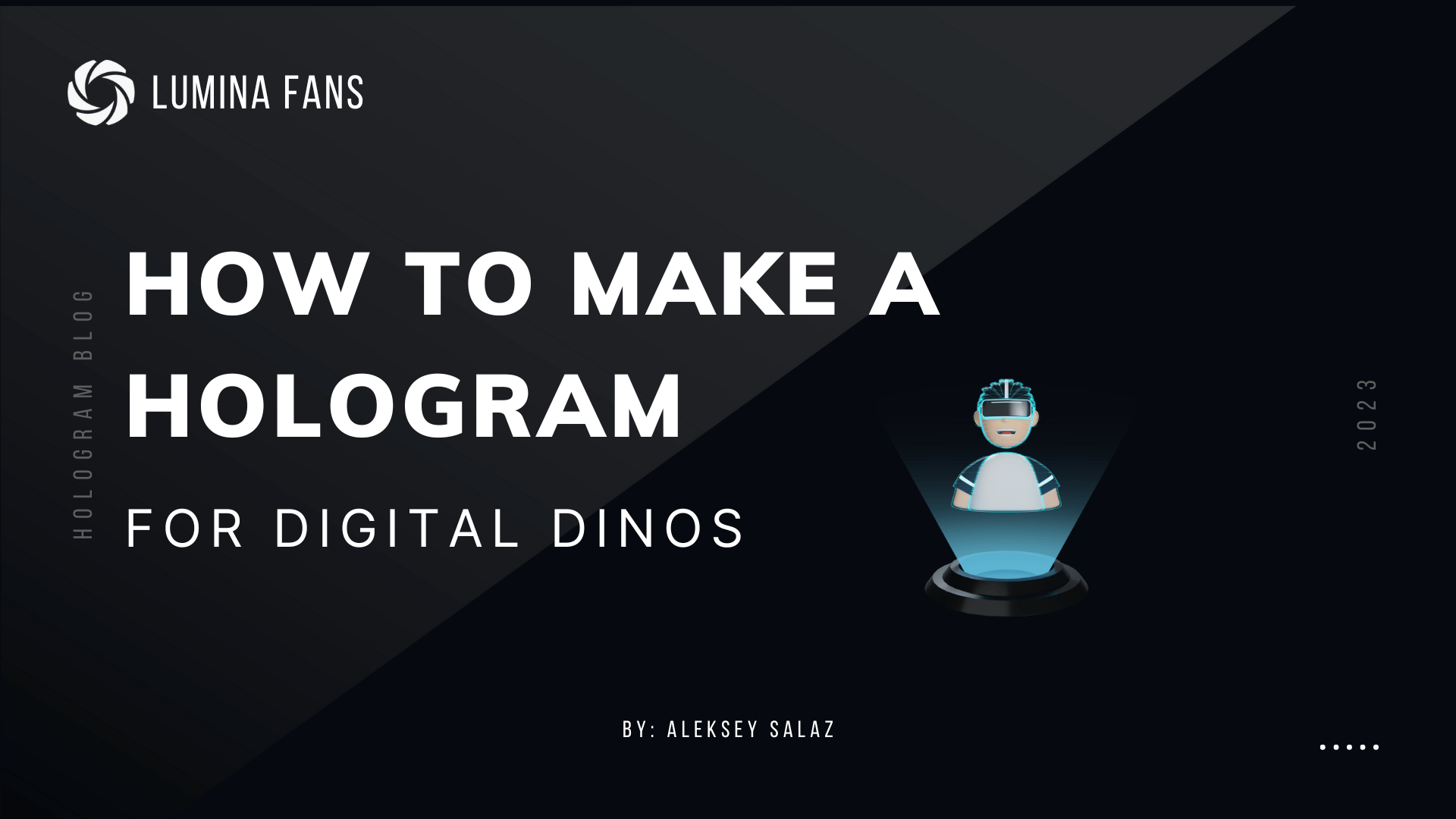This article is your treasure map to five advertising sign ideas. They're not only eye-catching, they stick in your mind.
Ready to dive into the exciting world of advertising that truly stands out?
Advertising Sign Ideas Snapshot:
- Holographic Fans
- LED Displays
- Interactive Digital Kiosks
- Projection Mapping
- Augmented Reality (AR) Signs
1. Holographic Fans: The Future of Advertising Signs
What Are Holographic Fans?
Have you ever seen a movie with 3D images floating in the air, like magic? That's what holographic fans do in real life. They are cool devices that spin super fast.

As they spin, they use lights to create amazing 3D images that seem to float in the air. These images aren't in a frame or on a screen. They're right there in front of you, like a scene from a sci-fi movie.
Why They're Awesome for Advertising
Let's talk about why holographic fans are changing the game in advertising. First, they grab your attention. When you see a 3D image floating in the air, you can't help but stop and look. That's exactly what businesses want when they advertise.
Second, these fans can show off products in a way that feels almost real. Imagine seeing a new sneaker or a cool drink spinning in the air, looking like you could reach out and grab it. That's powerful advertising!
Examples of Holographic Fan Advertising
- Storefront Windows: Imagine walking by a store and seeing a holographic display of the latest fashion or tech gadget. It's a surefire way to pull people into the store.
- Trade Shows: At busy trade shows, a holographic fan displaying your product can make your booth the center of attention.
- Event Promotion: Use a holographic fan to promote special events. It can display dates, times, and exciting visuals that make people want to join in.
2. LED Displays: A Bright and Bold Advertising Sign
Lighting Up the Advertising World
Picture a vibrant display that lights up the street, turning heads day and night. That’s the impact of LED displays in advertising. These displays use tiny lights to create big, bright images.

They’re perfect for catching attention in busy areas, and they shine bright, even under the sun. LED displays are a game-changer, making any ad more visible and engaging.
The Advantages of LED in Advertising Signs
Why are LED displays a top choice for advertising signs? First, they’re energy-efficient, meaning they use less power and are better for the environment. They also last longer than traditional bulbs, saving you time and money on maintenance.
Plus, the ability to quickly change the content makes them ideal for keeping your advertising fresh and up-to-date.
Ideal Places for LED Signage
- Billboards and Outdoor Spaces: Whether on a busy highway or in a bustling city center, LED billboards are hard to miss. They’re great for sharing everything from advertising to public information.
- Indoor Advertising: In shopping malls or stores, LED signs can highlight promotions or direct customers to different sections.
- Event Displays: At events like sports matches or concerts, LED screens add to the excitement, showing live action, replays, or promotional content.
Creating Impactful Messages with LED
With their vibrant colors and dynamic content, LED displays are more than just signs; they’re storytelling tools. They bring your message to life, whether you’re announcing a grand opening, showcasing a new product, or promoting a special event.
In a world where advertising signs are everywhere, LED displays make sure your message doesn’t just blend into the background but stands out brilliantly.
3. Interactive Digital Kiosks: A Personal Touch in Advertising Signs
Engaging Customers in a New Way
Imagine an advertising sign that talks back! Interactive digital kiosks do just that. They're like big touchscreens you often see in malls or airports.

These kiosks let customers interact with them, providing a unique and personalized experience. This two-way communication makes advertising more engaging and memorable.
Why Interactive Kiosks Stand Out
Interactive kiosks stand out because they do more than just show ads. They invite people to engage. Customers can browse products, get information, or even play games. This interaction means customers spend more time with your ad, and that’s good for business.
Plus, these kiosks can be updated easily, keeping content fresh and relevant.
Where to Place Interactive Kiosks
- In Store Promotions: Set up a kiosk inside your store to showcase new products or offer special deals. It’s a great way to engage customers and boost sales.
- Trade Shows and Events: At events, kiosks can provide information, register attendees, or display interactive content related to the event.
- Public Spaces: In areas like train stations or city squares, kiosks can serve as information hubs or even as interactive city guides.
The Power of Personalization
What really makes interactive kiosks shine is personalization. They can be programmed to offer personalized recommendations or information based on user interaction.
This personal touch can make a big difference in how customers perceive your brand and advertising. It’s not just about displaying a message; it’s about creating an experience that resonates with the audience.
4. Projection Mapping: A Visual Spectacle in Advertising
Turning Surfaces into Canvases
Imagine a building's facade transforming into a vibrant storytelling canvas. That's what projection mapping does. It's a technique that uses projectors to cast images onto any surface, making them come alive with motion and color.

This technology turns ordinary buildings, cars, or even stages into astonishing 3D displays, creating unforgettable advertising experiences.
Why Projection Mapping is a Game-Changer
Projection mapping is more than just projecting images; it's about creating immersive experiences. This technology can warp and blend light onto irregular shapes, making images seem to jump out or move with the surface.
It’s perfect for big reveals, product launches, or simply making an advertising sign that people will stop and watch in awe.
Ideal Venues for Projection Mapping
- Building Exteriors: Turn the side of a building into a massive advertising billboard that can tell a story or showcase a product in a dramatic way.
- Live Events: Use projection mapping at concerts, festivals, or sports events to create dynamic backdrops and enhance the audience's experience.
- Interactive Art Displays: Combine projection mapping with interactive elements to create engaging public art installations that also serve as advertising.
Maximizing Impact with Creative Content
Projection mapping's success lies in its content. Creative and well-thought-out visuals can make a simple wall turn into a mesmerizing story. This medium offers limitless possibilities, allowing advertisers to push boundaries and explore new ways of conveying their message.
It's all about creating a 'wow' moment that makes the advertising sign unforgettable.
5. Augmented Reality (AR) Signs: Engaging the Senses
Bringing Ads to Life with AR
Imagine pointing your phone at a simple poster and watching it come to life. That's augmented reality (AR) in action. AR adds digital elements to the real world, seen through a smartphone or AR glasses.

It turns a standard advertising sign into an interactive experience. From 3D models of products to animated stories, AR makes ads unforgettable and fun.
The Edge of AR in Advertising
AR signs are revolutionary because they transform how we interact with ads. They're not just to look at; they're to experience. With AR, you can try on clothes virtually, see how furniture looks in your home before buying, or unlock special content.
This interaction isn’t just cool; it also helps customers connect with your brand in a deeper way.
Perfect Places for AR in Advertising
- Retail Stores: In-store AR signs can enhance the shopping experience, offering virtual try-ons or product information.
- Outdoor Advertising: Billboards or posters with AR can engage passersby, turning a quick glance into an interactive moment.
- Events and Exhibitions: Use AR to add a layer of interactivity to your event, making booths or displays more engaging and informative.
Creating Connections with AR Technology
What sets AR apart is its ability to create a personal connection. It's not just showing a product; it's letting people experience it in their space.
This personalization makes AR an incredibly powerful tool in advertising. It's about creating a memorable experience that goes beyond the sign and stays in the minds of the audience.
Conclusion: Making Your Mark with an Advertising Sign
In today's fast-paced world, catching and keeping attention is key. The advertising sign ideas we've explored – from the magic of holographic fans to the immersive world of AR – show just how creative you can get. Each of these technologies offers a unique way to bring your message to life and make a lasting impression.
Remember, in the crowded space of advertising, being bold and innovative is what sets you apart. It's time to think outside the box and create advertising signs that don't just display your message but tell your story in an unforgettable way.
Ready to Elevate Your Advertising Strategy?
If you're inspired to take your advertising to the next level, don't wait. Explore these innovative ideas and see how they can fit into your marketing plan.
Whether you're a small business or a large corporation, there's an advertising sign solution that's perfect for you. Start making your mark today and ensure your brand is anything but invisible.
Frequently Asked Questions About Advertising Signs
What is an Advertising Sign?
An advertising sign is a visual communication tool used to convey a message to a target audience. It can range from digital displays, banners, and billboards to more innovative forms like holographic projections and interactive kiosks. The primary purpose is to promote products, services, or brands and attract customers.
What is an Example of Sign Advertising?
A common example of sign advertising is a billboard on a busy street showcasing a new product or service. Other examples include digital LED displays in shopping malls, promotional banners at events, and interactive signs with QR codes for immersive experiences.
What Do You Put on an Advertising Sign?
Effective advertising signs often include a compelling message, brand logo, striking visuals, contact information, and a clear call-to-action. The content should be concise, easy to read, and designed to capture the audience's attention quickly.
Are Yard Signs a Good Way to Advertise?
Yard signs can be an effective advertising tool, especially for local businesses or community events. They are affordable, easy to install, and can reach a local audience effectively when placed in high-visibility areas.
What is the Most Eye-Catching Color for Advertising?
Bright and bold colors like red, yellow, and orange are generally considered the most eye-catching in advertising. These colors are known to grab attention quickly and make a strong visual impact.
What is the Most Eye-Catching Color for Signs?
For signs, bright colors like red and yellow are often used to catch the eye. However, the effectiveness of a color also depends on contrast and background. For example, black text on a yellow background is highly visible and eye-catching.
What Color Immediately Attracts Attention?
Red is known to immediately attract attention due to its association with urgency and importance. It's a powerful color often used in advertising to draw immediate attention.
What Color Catches Attention Fastest?
Yellow catches attention fastest due to its high visibility and brightness. It's often used in caution signs and advertising materials to quickly grab viewers' attention.
What Color is Best for Advertising?
The best color for advertising depends on the context and message. However, colors like red, yellow, and blue are popular choices. Red evokes excitement, yellow stands for optimism and attention-grabbing, while blue conveys trust and reliability.


